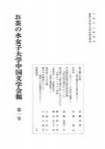タイトル
書名一覧を表示するには、JavaScriptをONにして下さい。
もしくは、こちらのページから書名を選択して下さい。
もしくは、こちらのページから書名を選択して下さい。
2023年12月に学術雑誌のページはリニューアルしました。新しい学術情報のページはこちらをご覧ください

お茶の水女子大学中国文学会報
Bulletin of the Sinological Society Ochanomizu University
発行:お茶の水女子大学中国文学会
ISSN:02866889
第1巻(1982)~
第41巻 (2022-04-16)
表紙 cover |
|
前号目次 |
|
| p.1-19 |
曹植の遊仙詩について― 「鼎湖」の典故を手掛かりとして― Fairy Poems of Cao Zhi: The Allusion About Ding Hu as a Clue |
| p.21-35 |
周興嗣の病と「一夜白髪」説 Zhou Xingsi’s Illness and the“ One Night of White Hair” |
| p.37-43 |
交流 |
| p.44-46 |
活動報告―二〇二一年度― |
| p.47-50 |
中国文学会会則・投稿規定 |
| p.(1)-(18) |
「舜子変」の民間文芸に於ける伝承について Transmission of“ Shun Zi bian 舜子変” in Folk Literature |
| p.(19)-(39) |
王安憶作品中の家政婦と家具の関係―『好姆媽、謝伯伯、小妹阿姨和妮妮』と『鳩雀一戦』の分析を中心に― A Study on the Relation between Maid and Furniture in Wang Anyi’s Novels: Focusing on the Analysis of “Auntie Well, Uncle Xie, Maid Xiaomei and Nini” , and “Warfare between dove and sparrow” |
| p.(41)-(55) |
黄春明「莎喲娜啦・再見」に描かれる記憶とアイデンティティの形成 Memory and Identity Formation in Huang Chun-Ming “Sayonara/Zaijian” |
| p.(57)-(79) |
中国語の副詞〝可〞の語気 On the modality of“ ke” in Mandarin Chinese |
| p.(81)-(99) |
テアル構文との対照にみる中国語の存在表現 Existential Expressions in Chinese from a Comparative Perspective with the“ te-aru” Construction |
| p.(101)-(115) |
清東陵の人と言語 People and Language of the Eastern Qing Tombs |
| p.(117)-(129) |
コーパスにおける〝了1〞と共起する動詞に関する調査 A Survey on Verbs Co-occurring with“ Le₁” in the Corpus |
編集後記・奥付 imprint |
|
裏表紙 backcover |
